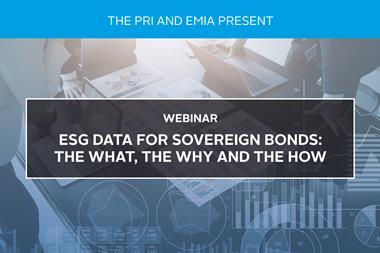This guide is designed to help PRI signatories integrate ESG factors into the research and analysis of sovereign issuers and the construction of sovereign debt portfolios. It is intended for ESG specialists, sovereign debt analysts and fixed income (FI) portfolio managers as well as investment consultants. It includes lists of useful data sources, practitioner case studies and a comparison of how the application of ESG techniques can differ between emerging and developed markets, with Argentina and France as examples.
Why integrate ESG factors into sovereign credit analysis?
Sovereign bond investors already integrate some ESG metrics into research, valuations and asset selection, while some financial and macroeconomic indicators have an ESG component. However, systematic ESG integration is rarely applied to sovereign debt analysis, due to a lack of consistency in defining and measuring material ESG factors, limits to data availability and generally less-developed sovereign debt ESG integration tools and techniques. Furthermore, because sovereign debt was traditionally considered a risk-free asset class, there has been a tendency to underestimate the importance of ESG integration relative to other FI asset classes.
Despite these barriers, there is a growing case for ESG integration in sovereign bond investment, with the global financial crisis reminding investors of the limitations of conventional thinking, and academic and industry research increasingly identifying relationships between ESG factors and sovereign bond risk and pricing. There is also an increasing focus on how environmental and social factors impact valuations, despite investors generally agreeing that governance factors have the greatest impact.
What are the key ESG factors?
Identifying ESG factors relevant to sovereign debt markets is challenging and, given the dynamic nature of ESG issues, it is not possible to draw up a definitive list. Investors need to consider time horizons and materiality, in light of policy and institutional stability, and the level of financial flexibility sovereigns have to withstand environmental, social or external shocks. They also need to take into account the interdependency between many ESG factors, and the fact that a sovereign’s economic performance, and the ability of its government to repay debt, is different from that of a company.
Nonetheless, on a positive note, a number of material ESG related quantitative and qualitative indicators are publicly available and can be integrated into sovereign bond analysis.
- Governance has traditionally been regarded as the most material ESG factor for sovereign debt and has been extensively incorporated into credit rating models and valuations. Investors can seek measures of a country’s political stability, government and regulatory effectiveness, institutional strength, levels of corruption and the rule of law.
- Social factors can also be material in sovereign credit analysis due to the importance of human capital as a key determinant of economic growth. Measures of demographic change, education, living standards, income inequality and social cohesion can inform sovereign bond valuations.
- Environmental factors have typically been less analysed by sovereign debt investors, although this is changing as the physical and economic impacts of climate change and resource constraints become more evident. Investors are increasingly considering measures of natural resource availability, physical risk from climate change and other natural disasters, energy transition risk and energy security.
What tools and techniques are useful for ESG integration?
Investors are beginning to develop a range of tools and techniques to measure and integrate ESG factors into sovereign debt research, valuation and portfolio construction on a systematic basis. Some of these refine existing processes and approaches, while new techniques are also emerging.
This guide draws on the ESG Integration Framework, developed jointly by the CFA Institute and the PRI, to consider how investors might integrate ESG factors into their sovereign debt investment1. It covers research, security valuation and portfolio management:
- Investment research level: Investors may consider undertaking in-house country-level ESG research and developing materiality frameworks. This process can result in red-flag indicators, watch lists, and centralised research dashboards that are easily accessible across teams. Such research is also useful to establish whether engagement with issuers is necessary and, if so, which form (individual or collaborative) it should take.
- Security level: Investors may consider carrying out ESG-integrated credit analysis, including internal credit assessments and relative rankings, as well as relative value and spread analysis. Some investors also adjust forecasted financials and ratios in light of ESG analysis. Sensitivity and scenario analyses can also be useful.
- Portfolio level: Investors may assess the combination of ESG factors at the portfolio level to inform portfolio construction and to better manage risk exposure.
Next steps
The report is based on guidance from an expert working group, a 2018 CFA Institute and PRI ESG integration study, which surveyed 1,100 practitioners globally, and extensive desk research. It complements other PRI guidance on integrating the PRI’s six Principles into investment practices and active ownership.2
In particular, this report builds on a 2013 PRI primer.3 Since then, awareness among practitioners regarding this topic has increased significantly and investment practices have evolved. This report captures recent progress and provides guidance. However, important questions remain unanswered and more work is needed to understand the investment implications of rapidly evolving ESG risks as measurements, assessment tools and techniques improve.
For example, it remains to be seen how ESG integration can play a role in the context of highly liquid debt markets, where investors are often obliged to hold specific bonds when benchmarking an index or because of credit rating constraints. Also, the role and limitations of ESG engagement in a sovereign context need to be further explored and clarified. Finally, this paper deliberately does not discuss thematic bonds, such as green bonds, in order to avoid mixing the concept of assessing ESG factors from a pure risk perspective for any sovereign bond with the concept of impact investing (or raising capital for a specific purpose).
Download the full guide:
Downloads
PRI Practical Guide to ESG Integration in Sovereign Debt 2019
PDF, Size 4.26 mb
References
1 CFA Institute and PRI (2018). Guidance and case studies for ESG integration – equities and fixed income.
2 See www.unpri.org/investor-tools.
3 PRI (2013). Sovereign bonds: spotlight on ESG risks.




















